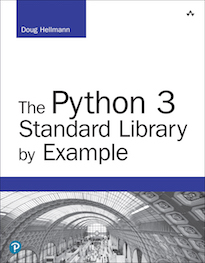Application Building Blocks¶
The strength of Python’s standard library is its size. It includes implementations of so many aspects of a program’s structure that developers can concentrate on what makes their application unique, instead of having to write all of the basic pieces over and over again. This chapter covers some of the more frequently reused building blocks that solve problems common to so many applications.
argparse is an interface for parsing and validating command
line arguments. It supports converting arguments from strings to
integers and other types, running callbacks when an option is
encountered, setting default values for options not provided by the
user, and automatically producing usage instructions for a program.
getopt implements the low level argument
processing model available to C programs and shell scripts. It has
fewer features than other option parsing libraries, but that
simplicity and familiarity make it a popular choice.
Interactive programs should use readline to give the user a
command prompt. It includes tools for managing history,
auto-completing parts of commands, and interactive editing with
emacs and vi key-bindings. To securely prompt
the user for a password or other secret value, without echoing the
value to the screen as it is typed, use getpass.
The cmd module includes a framework for interactive,
command-driven shell style programs. It provides the main loop and
handles the interaction with the user so the application only needs to
implement the processing callbacks for the individual commands.
shlex is a parser for shell-style syntax, with lines made up of
tokens separated by white-space. It is smart about quotes and escape
sequences, so text with embedded spaces is treated as a single token.
shlex works well as the tokenizer for domain-specific languages
such as configuration files or programming languages.
It is easy to manage application configuration files with
configparser. It can save user preferences between program
runs and read them the next time an application starts, or even serve
as a simple data file format.
Applications being deployed in the real world need to give their users
debugging information. Simple error messages and tracebacks are
helpful, but when it is difficult to reproduce an issue a full
activity log can point directly to the chain of events that leads to a
failure. The logging module includes a full-featured API that
manages log files, supports multiple threads, and even interfaces with
remote logging daemons for centralized logging.
One of the most common patterns for programs in Unix environments is a
line-by-line filter that reads data, modifies it, and writes it back
out. Reading from files is simple enough, but there may not be an
easier way to create a filter application than by using the
fileinput module. Its API is a line iterator that yields each
input line, so the main body of the program is a simple for loop.
The module handles parsing command line arguments for filenames to be
processed, or falling back to reading directly from standard input, so
tools built on fileinput can be run directly on a file or as part
of a pipeline.
Use atexit to schedule functions to be run as the interpreter is
shutting down a program. Registering exit callbacks is useful for
releasing resources by logging out of remote services, closing files,
etc.
The sched module implements a scheduler for triggering events
at set times in the future. The API does not dictate the definition
of “time,” so anything from true clock time to interpreter steps can
be used.
- argparse — Command-Line Option and Argument Parsing
- getopt — Command Line Option Parsing
- readline — The GNU readline Library
- getpass — Secure Password Prompt
- cmd — Line-oriented Command Processors
- shlex — Parse Shell-style Syntaxes
- configparser — Work with Configuration Files
- logging — Report Status, Error, and Informational Messages
- fileinput — Command-Line Filter Framework
- atexit — Program Shutdown Callbacks
- sched — Timed Event Scheduler
 PyMOTW-3
PyMOTW-3